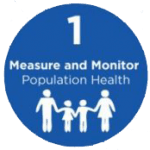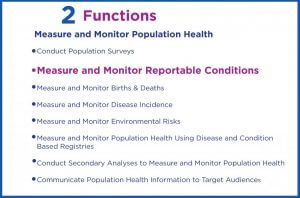This model is intended to serve as a jumping-off point for considering how information technologies support that work, clarifying where process improvements can enhance effectiveness and efficiency, and identifying which activities could benefit from further study.
What is the work of public health?
Problem: different systems, similar functions

Program-specific silos often drive information system development and acquisition.
- Common needs should drive common solutions. Yet little collaborative development of system requirements or applications occurs.
- Public health is an information enterprise, yet few agencies create an agency-wide vision and strategy for improving their information roles.
- Many health departments have isolated systems—with common functions—unable to interact with each other or the private sector.
- Redundant functions create high maintenance and other costs.
Solution: defining the work of public health from an information perspective
When agencies can clearly define their work, they can articulate a clear picture of how information systems should support their work. Using PHII’s Collaborative Requirements Development Methodology, the Public Health Information Model guides development of integrated information strategies and technologies that effectively support the work of public health.
- Improves information system design and use, and business process efficiency.
- Serves as a starting point for system acquisition that truly supports agency work.
- Provides an agency-level view for identifying similar system functionalities.
- Improves information flow between programmatic areas.
 Defining the Business Process Measure & Monitor Reportable Conditions
Defining the Business Process Measure & Monitor Reportable Conditions
Examining one specific work area from the above diagram (“work areas for public health”) provides an illustrative example of how PHII defines business processes. The first step is to identify individual functions within a work area. In this case, what functions are involved in measuring and monitoring population health?
The next step is to lay out the necessary business processes involved in a function. Using the above function “measure and monitor reportable conditions” as an example, the business process matrix below breaks down the business processes contained in that specific function. What processes must occur before “measuring and monitoring reportable conditions” is completed? What triggers the system that this function is needed, and what measurable outcomes signal that it is complete?
The process of mapping out tasks provides more detail about how an information system can support activity within a business process. The task flow below captures the business processes outlined above in an actionable flow chart. For a full analysis of a system, each function within each work area would need to be analyzed for a full report of business processes and task flows.



